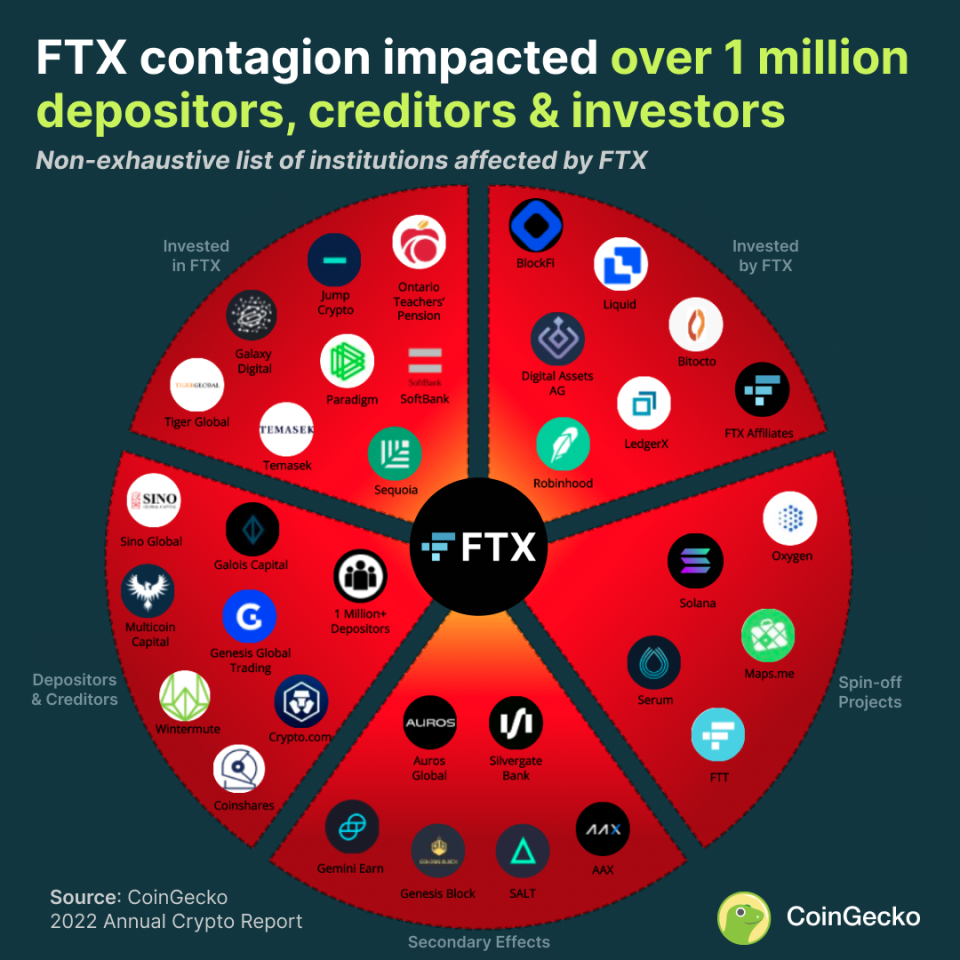Crypto’s hard landing and return to fundamentals highlighted in CoinGecko report

Cryptocurrency aggregator CoinGecko has released its annual report, highlighting how de-fi tokens had a torrid time and spot trading was on its knees at the end of 2022.
The 2022 Annual Crypto Industry Report details how the crypto market capitalisation lost more than half its value, ending the year at $829 billion, plunging the industry into a crypto winter, after two years of market exuberance.
It also examines the state of the crypto market and its various sectors, in the wake of major collapses last year. Trading volumes were down, with NFTs and DeFi among the hardest hit sectors, while stablecoins had a mixed performance.
Against a backdrop of increasingly severe macroeconomic conditions, Bitcoin’s performance fared worse than major traditional assets. Despite the crypto bubble bursting, continued development strengthened fundamentals, including Ethereum’s successful Merge and preparations for the Shanghai upgrade. Overall, in spite of bearish sentiments, the number of Bitcoin and Ethereum addresses have continued to grow.
“2022 marked a turning point for the crypto industry – one that flushed out unsustainable excesses from the bull run,” said Bobby Ong, COO and co-founder of CoinGecko.
“In this new year, we hope to see crypto slowly make a recovery, with more efforts going towards rebuilding trust and credibility.”

Annual report highlights:
1. After significant losses in Q2, the crypto market consolidated at half the value
The challenges from global macroeconomic conditions were compounded by the crypto industry’s debacles, bankruptcies and exploits. Total crypto market capitalisation started the year at $2.3 trillion, and in Q2 dropped below $1 trillion for the first time since August 2021. Markets trended sideways through the second half, ending the year 64.1% lower at $829 billion.
2. Stablecoins gained in crypto dominance, but lost from net outflows
Crypto investors turned towards safer assets last year, with the top three stablecoins Tether (USDT), USD Coin (USDC) and Binance USD (BUSD) increasing their dominance in the crypto market. Nevertheless, the TerraUSD (UST) collapse in May sparked a net outflow of $27.3 billion from stablecoins over the year, or a 16.6% decrease in market capitalisation. Stablecoins were comparatively resilient in the second half, despite periodic fears of another depegging event.
3. Bitcoin performed the worst, compared to major assets
Major assets performed poorly across the board and ended with yearly price returns in the red, except for crude oil and the US Dollar Index (DXY), which saw a 6.4% and 8.0% gain, respectively. Among these assets, Bitcoin (BTC) recorded the steepest decline of 64.2%, which was almost twice that of NASDAQ (-34%) and at least thrice of S&P 500 (-20%).
4. Ether staking saw steady quarterly growth, driven by Ethereum upgrades
Despite the crypto bear market, staked ether (ETH) grew steadily quarter-on-quarter (QoQ) throughout the year. Total number of staked ETH reached 15.8 million by year end, up from 8.8 million. Following Ethereum’s successful Merge in mid-September, total staked ETH posted notable growth of 12.5% in Q4. This indicates that bear market sentiments were outweighed by anticipation for Ethereum’s Shanghai upgrade, which will allow staking withdrawals and is slated for March 2023.
5. DeFi sector still reeling from major setbacks
The market capitalisation of DeFi tokens plummeted by 72.9% year-on-year (YoY) to $17.9 billion, the lowest in two years. Terra’s collapse in Q2 wiped out billions across the DeFi ecosystem, and FTX’s collapse in Q4 led to a further decline of 24.4% QoQ. Lending protocols (-80.5%) and yield aggregators (-85.3%) were the worst-performing verticals for the year, due to inflated valuations and capital withdrawals.
6. Amid first NFT winter, OpenSea defends leading position
The top five NFT marketplaces’ trading volume plunged sharply by 93.2% in December, compared to the all-time high in January. OpenSea continued to dominate with a market share of 65.4% as of year end, albeit 24.3 percentage points lower than at the start of the year, as the rise of Solana NFTs propelled Magic Eden to a 12.5% share.
NFT creator royalties similarly shrank by a significant 94.9%, to lows of $16 million in December.
7. Spot trading declined to all-year lows in December
Spot trading volume across the top 10 cryptocurrency exchanges reached $1.5 trillion in January, but sank 67.3% to an all-year low of $0.46 trillion in December. The dwindling volumes point to crypto investors distancing themselves from the market, or exiting it entirely.
Despite FTX’s collapse highlighting centralization risks, the ratio of trading on centralised exchanges to decentralised exchanges remained relatively unchanged. As at the year end, centralised exchanges commanded 92.5% of trading volume.
Read the full 2022 Annual Crypto Industry Report here.